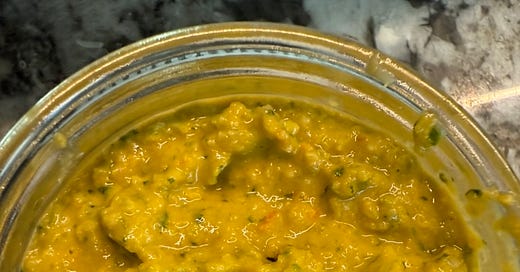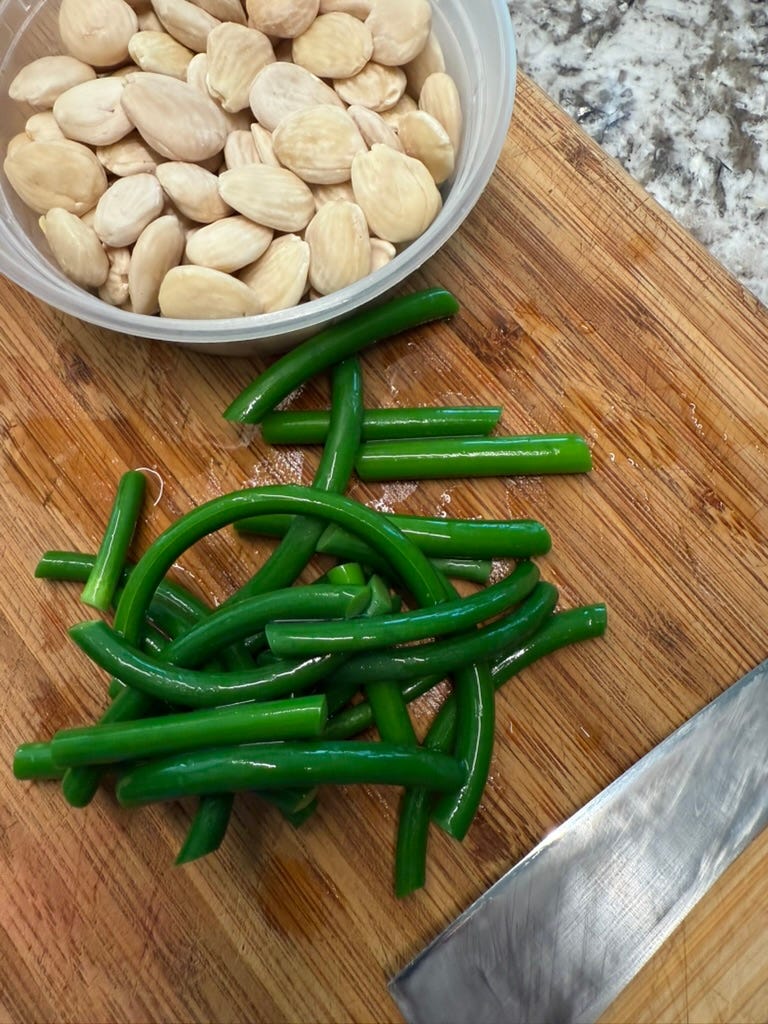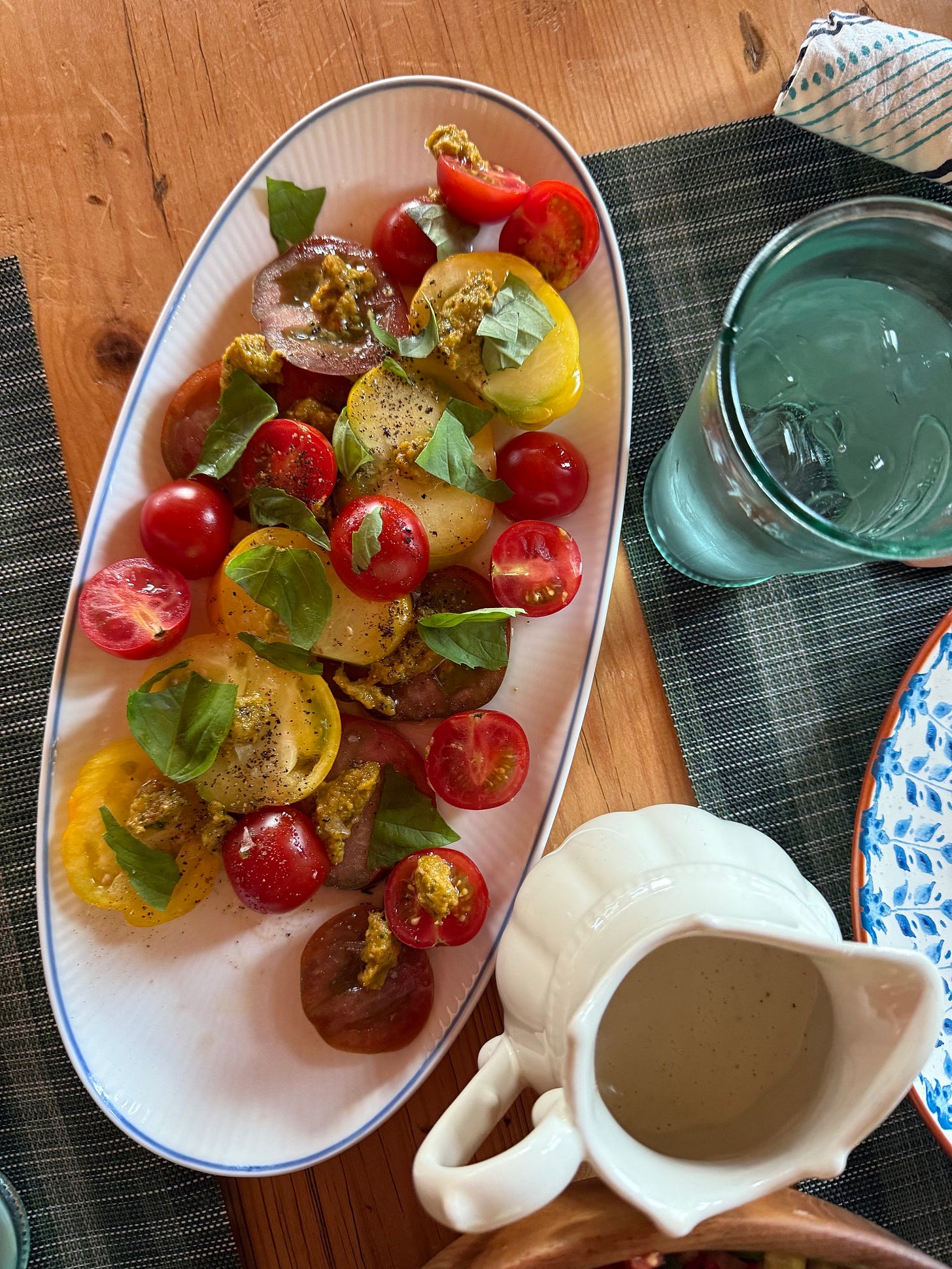Issue #213: Sicilian Pesto with Garlic Scapes
My First CSA, More Recipe Writing, A Different Pesto
My second year as a recipe contributor to the weekly Edgewater Farm CSA (Community-Supported Agriculture) newsletter has begun.
In all my years of supporting local farms, it wasn’t until we moved to New Hampshire last year that I joined my first CSA. In NYC, my dining schedule was too unpredictable for a weekly vegetable order to make sense. There were times I had to dine out seven nights a week for work and social obligations. However pristine any local, seasonal produce might have been, it would have rotted in the fridge to my dismay. Plus, milling about the Union Square Greenmarket, taking in all that variety and abundance, even when I wasn’t shopping, was a true delight.
Here in the Upper Valley, where the dining options are limited to none, we cook and entertain mostly at home. Edgewater is just down the road from our house. Before we even moved here, I had joined their CSA.
Imagine my surprise when a few weeks after having moved, back in Manhattan at a book party on the Upper East Side, I learned from a Brooklyn-based friend and colleague Liz Alpern—co-founder of The Gefilteria and co-author of The Gefilte Manifesto—that she was close friends with the owners of Edgewater, whom she encouraged me to meet.
The day I got home I DM-ed the farm on Instagram @edgewaterfarm and received a head-exploding emoji in response. I walked down the hill with Milo to say hi. Ever since, Jenny and Ray and the whole Sprague family have been friends.
Of the many ways I could help support the farm, it seemed providing a recipe or two each week to help CSA members figure out what to do with the produce they receive most fit with my work cadence and capacity. On Mondays (or sometimes Tuesdays), Jenny texts me the “pick list,” and then I try to think of something simple and rewarding to make with as many of the ingredients in that week’s haul as possible.
Last year I drew mostly on recipes I’d already published in my cookbooks, in this newsletter, and elsewhere. This year, just two weeks in, I seem to be creating and testing new recipes for the vegetables on hand. To wit, this week’s Sicilian pesto made with garlic scapes instead of cloves, and cherry tomatoes. (You can find other recipes I’ve developed for Edgewater, including a Middle Eastern chopped salad with strawberries, on their blog.)
Every year, one of the first things available in any farm stand or farmers market are garlic scapes, the green, curlicue flower-stalks hardneck garlic varieties shoot out before their bulbs form. Although enthusiastically received as a harbinger of delicious things to come, garlic scapes are difficult to use in any significant quantity. Luckily, they keep for weeks in the fridge. I chop them and sauté them into anything that calls for garlic or onions. I’ve pickled them, stir-fried them, puréed them into soups, and even grilled them to garnish tacos.
This year I thought to use them in a Sicilian pesto.
The first time I ever heard of or tasted a Sicilian pesto was in my own apartment on West 24th St. A friend from Italy who had accepted a visiting professorship at NYU, Fabio Parasecoli, was staying in my spare room for a few months while he taught a course in the Food Studies department. Fabio, who was from Rome, was making dinner for some friends. He whizzed together almonds, tomatoes, garlic, and pecorino in my food processor as I watched incredulously. The only “authentic” pesto I had known was made with basil and pine nuts. I sort of thought he made it up.
Since then, I’ve seen this pesto on menus in various parts of Italy, including Sicily, where it is known more precisely as pesto alla trapanese, that is, from the Sicilian fishing port of Trapani. (The more common basil-and-pine-nut pesto is known as pesto alla genovese, from the Ligurian capital of Genova.)
Technically, pesto just means “ground or crushed to a paste,” so you can really make a pesto from just about anything. Arugula and walnuts is a popular combination. The fat and protein in nuts and cheese help create a stable emulsion with olive oil. A proper pesto made with a mortar and pestle has a more subtle flavor and elegant texture than one done in the food processor, but it is a time-consuming labor of love that requires some practice to get right.
In this version of a Siclian pesto, I’m using garlic scapes both for gastronomic interest and to help use up the scapes that came in our CSA share. I blanched the scapes to preserve their green color and take the edge of their pungent flavor, but you can also use them raw. (Blanching the basil also helps preserve its color.) You can substitue scapes for some or all of the garlic in a pesto alla genovese, as well.
Use this pesto as you would any other, as a sauce for pasta, a dip for vegetables, a garnish for ripe tomatoes, or dabbed on grilled meat or fish. If you stir this pesto into fresh ricotta, you have a beautiful spread for grilled bread. Be creative.
RECIPE: Sicilian Pesto with Garlic Scapes
Different from its more common Ligurian cousin, Sicilian pesto (aka pesto alla trapanese) is made with the flavorful, local Sicilian almonds and tomatoes. Technically, pesto means “ground to a paste,” so feel free to experiment with ingredients. This week I made it with garlic scapes that I blanched (to keep their green color) and cherry tomatoes bursting with sweetness, both of which came in my CSA share. Use this pesto on pasta, as you would other pesto, or dab it on tomatoes, fresh ricotta, fish, and/or grilled meat. Clean out the bowl of the food processor with a hunk of fresh bread.
Makes 1 1/2 cups
4 or 5 large garlic scapes, cut into 2-inch pieces, without the bud (about 2 ounces)
1/2 cup blanched almonds, lightly toasted
4 large cherry tomatoes, halved
Handful of fresh basil leaves (about 1/2 cup)
Some fresh mint (optional)
Salt and freshly ground black pepper
1/2 cup extra-virgin olive oil
1/3 cup grated Pecorino Romano
If blanching the scapes, set a small bowl of ice water near the stove. Bring a small pot of salted water to a boil and blanch the garlic scapes for 1 minute to preserve their green color and remove the harsh edge of their flavor. Lift out of the boiling water and quickly place in the ice water to cool. (If you are making this pesto more than an hour or two in advance of consuming it, consider blanching the basil along with the scapes, which will prevent browning.)
Drain the scapes and place in the bowl of a food processor fitted with a metal blade. Add the toasted almonds, tomatoes, basil, mint, if using, a generous pinch of salt and some freshly ground black pepper. Pulse to finely chop the mixture, scraping down the sides to get an even paste. Once the paste is achieved, keep the machine running and slowly pour the oil through the feed tube to form an emulsion. Scrape down the sides from time to time. Add the cheese, pulse to blend, taste, and adjust the seasoning before using as indicated above. I use a hunk of fresh bread to wipe out the bowl so nothing is wasted.






